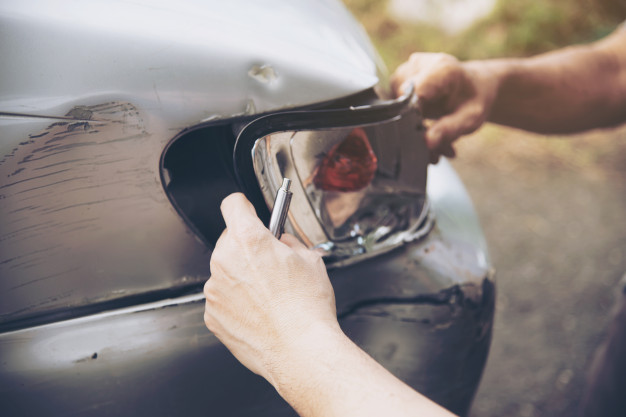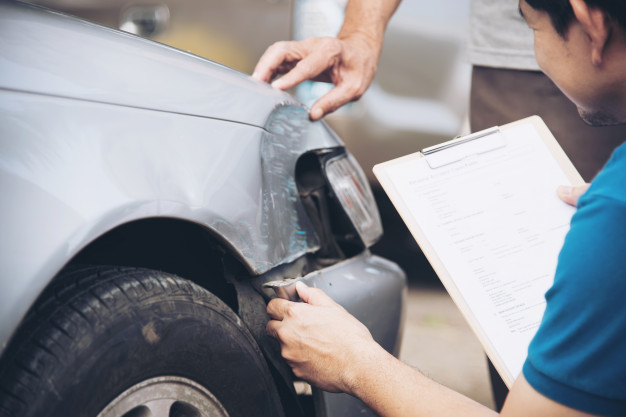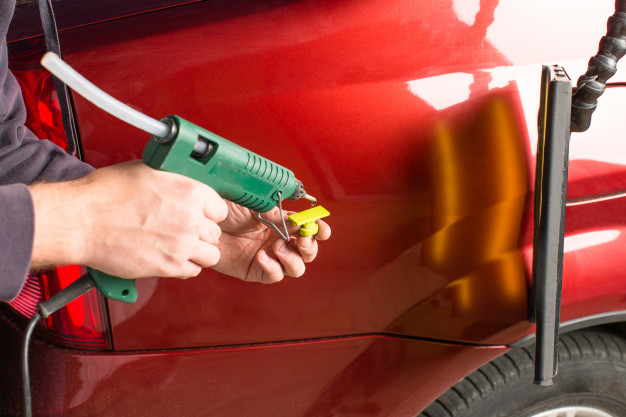Car dents are an inevitable part of the car-ownership life. No matter how careful you are, the risks of suffering through some dents and dings are always there. These small “wounds” are more than just a simple inconvenience, though. They’re everything but good for your fuel economy, and they can be quite a threat to your on-the-road safety.
Therefore, getting these fixed as soon as possible is of the utmost importance. Here we’ll tell you about all the ways to do it without spending too much of your money on repairs. We are all on a tight budget sometimes, but there’s no reason for your car to suffer because of it.
So, without any further ado, let’s get to the bottom of it!
When should you do it yourself?

Now, the cheapest way to get those dents fixed is by DIY-ing the entire project. As long as you have the necessary tools and proper skills, you’ll be able to get rid of the dings in no time whatsoever. However, make sure to consider all of your options beforehand. Sometimes, if a dent is particularly deep and stubborn, you could end up damaging your car instead of fixing it. So, remember to assess the situation carefully before reaching for your toolkit. Look carefully at where the dent is, as different parts of your car require varying degrees of care, some of which can’t be fixed with your regular dent-fixing tools.
If you have any friends in the industry, ask them for their opinion first. They’ll be able to tell you whether DIY-ing the repairs is a good option or not. If you’re interested in learning how to do it, keep on reading because we’ll go over it in a second!
Get a high-quality repair kit before anything else!

Now, getting rid of those dents without a proper dent-removal kit simply isn’t possible. Usually, these kits come with a bridge-type tool, which has legs for straddling the indentation. Mostly, you’ll be sticking some kind of a pulling attachment right in the middle of the dent. There’s nothing especially complicated in using these kits, but we still suggest watching a tutorial or two if it’s your first time using it. Even more importantly, don’t ignore the user manual that comes with these types of kits. Otherwise, you’ll be risking doing a poor job and potentially damaging your vehicle even further.
Other than that, remember to look for high-quality dent-removal kits while you’re at it. If the tools are of lower quality, chances are you’ll have a harder time removing those dings. We suggest you do some online research before going shopping. Also, since you’re on a tight budget, you could always try to look for sales, or perhaps even borrow a kit from your handy neighbor.
Of course, dents come in different sizes and occur on different parts of your vehicle. These factors will determine how you should proceed with the repairs.
What to do when there’s a dent in metal?

The first step is to clean the surface with a simple microfiber cloth. Even though this might seem unnecessary at first, it will ensure your car stays clean of particulates that can lead to paint damage. Use a glue gun from your repair kit and stick some hot glue to the deepest part of the ding. Attach the bridge puller and wait for the glue to dry. After about 5-10 minutes, slowly turn the dial to remove the ding. Be careful not to do it too rashly, as it can result in damages. Lastly, detach the bridge puller and remove the excess glue via a heat gun.
This will work for smaller dents, so if you’re dealing with a larger one, you’ll have to do some prep work to be able to do this successfully. Use your heat gun to heat up the dent (until it’s warm!), and reduce its size by pulling it with a suction puller.
What about plastic?

For those annoying dings in the plastic parts of your vehicle, you’ll need to make use of your heat gun/ blow dryer. Then, shake the compressed air, and spray the area with cool-air. In most cases, it should pop by itself. If not, grab your suction puller and finish the job manually. A similar process should be done for larger plastic dings. Warm the affected area, then pop it out using a suction puller. You may have to warm it a few times to get rid of the entire thing. Also, if smaller indentations appear during the process, simply push them out with your hands.
As you can see, DIY-ing the process is quite simple. Still, those kits can be quite pricey, and there’s always the risk of making it all worse if you’re not careful. So, in some cases, hiring a professional simply makes more sense. If you think hiring someone to do it for you is the only way out, paintless dent repair services should be your first choice.
PDR- the cheapest way to fix those dings

PDR services are usually completely covered by most insurers, which makes them one of the cheapest ways to fix your car and avoid the time-consuming DIY shenanigans. Besides, as there’s no need for the expensive paint job, you’ll get your car fixed in a matter of hours for a very low price. You can visit here for more information on the process if you’re interested in that.
Of course, a poorly done PDR can do your car more harm than good. So, make sure to choose a reliable servicer in your local area. Read up on their online reviews and testimonials, and ask around for some referrals.
The bottom line
Getting rid of dents on your car as promptly as you can is of the utmost importance. Fixing them keeps your drag coefficient down, which will in turn save you money on fuel. Besides, if they’re in metal, you’ll be up for an unpleasant surprise later on. Metal can rust away, so ignoring those small dings and dents can end up costing you thousands of dollars if you’re not careful.
If you’re on a tight budget but your car needs some dent-removal servicing, you can either DIY it or go for some PDRs (paintless dent repairs).




